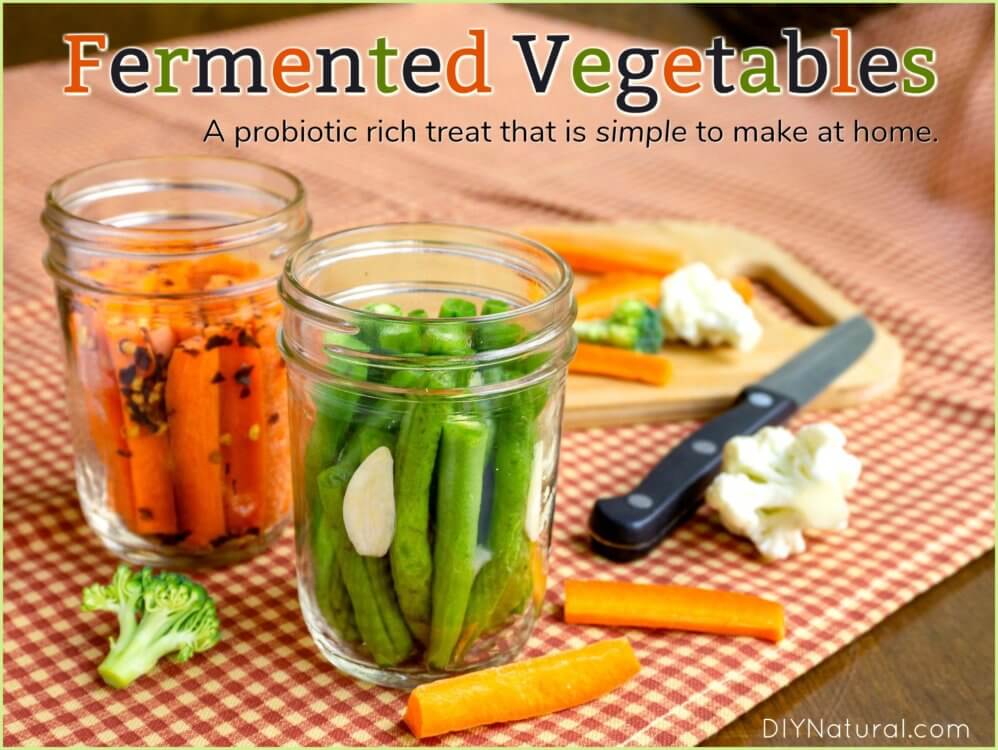

At first, I was intimidated to make fermented vegetables but I discovered that fermenting all vegetables is as simple and fun as sauerkraut.
Lacto-fermented vegetables. Sounds intimidating right?
I thought Lacto-fermenting involved milk or whey. And I wasn’t sure that milky vegetables would really be my thing.
Now, the funny thing is that I’ve been making my own sauerkraut for years. But, for some reason, I didn’t make the connection between fermented vegetables and sauerkraut.
Sauerkraut is easy. But, fermented vegetables seemed vague and difficult.
Once I dove in though, I found that fermenting any vegetable is just as easy as fermenting cabbage to make sauerkraut.
What Is Lacto Fermentation?
Lacto-fermentation actually has nothing at all to do with lactose or dairy. Here, “Lacto” is talking about lactic acid.
Fruits and vegetables typically have beneficial bacteria Lactobacillus on their surface. Often when we think about bacteria we think of it in a negative way, but not all bacteria are bad.
In fact, Lactobacillus is quite good.
When placed in an oxygen-free environment, Lactobacillus turns sugars into lactic acid. In turn, this lactic acid prevents the growth of harmful bacteria, acting as a preservative for the veggies, and giving fermented foods their tangy flavor.
The Benefits Of Fermented Vegetables
So, why would you want to make your own fermented vegetables?
There’s a lot of talk these days about gut health, as we’re discovering just how important our gut is to the health of our bodies as a whole.
Fermented foods add good bacteria to the gut. This good bacteria helps to do many things like strengthen the immune system and regulate appetite.
Fermented vegetables are a great and tasty way to get a daily dose of probiotics to maintain gut health.
The Best Vegetables To Ferment
Once you jump on the fermented veggie train, it’s hard not to want to FERMENT ALL THE THINGS!
So, what CAN you ferment?
- carrots
- green beans
- peppers
- radishes
- beets
- broccoli
- cauliflower
- whole pickling cucumbers
- and more!
Can You Ferment Any Vegetable?
Actually, you can ferment pretty much any vegetable. Some vegetables just require a little more care or a different process than others.
For example, delicate leafy greens and cabbages have so much moisture in them already that you don’t need a brine as we use in our recipe below; they create their own brine with just some salt.
Other vegetables with higher water content, like summer squash and sliced cucumbers, may get mushy during the ferment. These veggies benefit from adding an ingredient high in tannins, like grape leaves or black tea leaves.
Key Steps To Fermenting Vegetables
Fermenting vegetables might seem like a daunting task, but really, the steps are pretty simple.
Evenly cut ingredients. While you can ferment any vegetable you like, you’ll want to make sure the ingredients in your jar are roughly the same shape and size. This will ensure that they all ferment at the same rate.
Salt brine. Pack your fermenting jars with the vegetables and cover them with saltwater.
Keep everything submerged. The key to Lacto-fermentation is that it all has to happen in an oxygen-free environment. If any of the vegetables are exposed to oxygen, you’ll see your not-so-friendly mold appear. You can keep the ingredients submerged by nesting a smaller jar in a larger jar, placing a glass weight in the jar, or covering the ingredients with a cabbage leaf.
Taste your fermenting veggies. Fermentation is done when the veggies taste good to you. Fermentation can be fast or slow, depending on the temperature and the vegetables. So grab a taste every day or so to check flavors.
Store your fermented vegetables in a cool place once they have reached a flavor that you like. The refrigerator or a root cellar are great options. Cooler temperatures slow down fermentation, so your veggies will stay good for months!
Fermented Vegetables: A Basic Recipe
Yield 1 quart
I designed this recipe to be more of a guideline rather than a set recipe. Use whatever vegetables and whatever seasonings you like, and as long as you follow the fermenting steps you’ll have tasty, probiotic-rich snacks at your fingertips.
Ingredients
Instructions
- Fill a clean, wide mouth jar with the chopped vegetables, leaving at least 1½ inches of headspace.
- Add any seasonings you like.
- In a one quart liquid measuring cup, mix together 4 cups of water with 2 Tbsp sea salt, until the salt has dissolved.
- Pour the salt water brine over the vegetables in your jar, leaving one inch of headspace.
- Place a smaller clean jar (or other weight) inside the first jar to keep the vegetables submerged below the brine.
- Cover the jars with something breathable. (I like to use a paper coffee filter with a rubber band to hold it in place. Several layers of cheesecloth or a tea towel would also work well. If you choose to use a tight-fitting lid, you will need to open the jar every day to let some of the gasses escape. If you have a lid with an air-lock, that works too.)
- Leave your vegetables to ferment on the counter for 2-3 days. (The ideal fermenting temperature is 70-75°F.) Check them daily to be sure all the vegetables are staying below the brine. By 2-3 days, you should start to see some tiny bubbles forming at the top of the brine.
- Start tasting your vegetables after 2-3 days. Once they reach a flavor that is to your liking, you can remove the weight, cover the jar tightly, and place the fermented vegetables in the refrigerator. They are ready to enjoy!
Notes
Some great fermented vegetable combinations:
- Carrots with red pepper flakes
- Green beans with garlic and dill
- Carrots with ginger and garlic
- Broccoli and cauliflower with garlic, basil, and oregano
- Garlic with basil and oregano
- Beets, carrots, and fennel
- Cauliflower with curry powder
How To Use Your Fermented Vegetables
Fermented vegetables make a wonderful appetizer or garnish to a sandwich or grilled meats.
Or, just snack on them throughout the day, and know that you’re doing good things for your gut!
Have you ever fermented veggies? If so, what veggie combinations have you tried? Share with us below!
*******
Source: DIY Natural – Food






